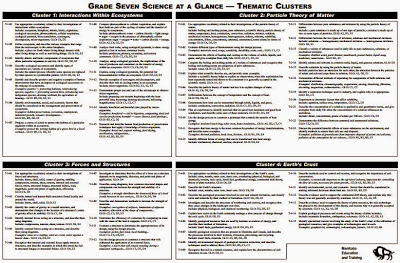How I Plan a Unit in 5 Steps

After finding out that I would be joining the “S-School” team as a full-time teacher, naturally, many of my blog posts turned to discussions of planning and sharing of classroom resources. Since that time, I’ve received quite a few emails regarding how I specifically go about planning out my classroom units. Now, I by no means consider myself any type of “expert” in classroom planning. In fact, with the ever changing face of education I don’t think anyone can truly master this task… ever. Furthermore, this is my first classroom, EVER, so everything is completely brand new to me and every single teacher and classroom is very different.
With that disclosure mentioned, however, I am more than happy to share the steps that I have been going through as I plan out my classes. Since I have already shared my resources for all of the units in my Grade 7 Science class, I will use this class as my example through this post.
 |
| Grade Seven Science at a Glance – Thematic Clusters. (2013). Manitoba Education & Training. Available online at: http://www.edu.gov.mb.ca/k12/cur/science/outcomes/5-8/topic_charts.pdf |
I started with the unit, Interactions with Ecosystems, and completed the Backwards-by-Design Method of Planning (also referred to as Understanding by Design). This involved me determining what Enduring Understandings I wanted my students to know at the end of the unit, and working backwards to determine the best activities and assessment strategies to meet this goal. Here are the questions I answer as I make my way through this process:
relationship between producers and consumers.
including abiotic and biotic components.
of photosynthesis, food webs, consumers, producers, scavenger, and
decomposers.
that they play: including abiotic and biotic components.
ecosystems.
consumers, producers, scavengers, and decomposers.
To read more about this method, check out this great PDF review. Manitoba teachers also have the awesome resources available from the Manitoba Rural Learning Consortium (mRLC) to assist them with their Backwards-by-Design planning.
 |
| I Spy an Ecosystem. (Accessed 2013). Uploaded by ASU Ask a Biologist. Available online at: http://askabiologist.asu.edu/explore/i-spy-ecosystem |
– Allowing appropriate time for assessment activities
|
Component
|
Checklist
|
|
Layered Curriculum
|
– Activities Divided Amongst Levels 1-4
|
|
Opportunities Outside of the Classroom
|
– Ecosystem Sampling Outdoor Activity
|
|
Lab Activity
|
– Ecosystem Sampling Outdoor Activity
– Candle in a Jar Activity
|
|
Mentoring Activity with Another Class
|
– Share Take Action Project with Another
Class
|
|
Community Involvement
|
———————————————————
|
|
Linguistic Activities
|
– Notes
– Debatable Qs Choices
– Handouts
– Entrance/Exit Slips
– Discussions
|
|
Logical/Mathematical Activities
|
– Ecosystems Sampling Outdoor Activity
– Candle in a Jar Lab
– Missing Ecosystem
– Food Web/E. Pryamid
|
|
Visual/Spatial Activities
|
– Ecosystem Illustrations
– Habitat Take Action Project
– Food Chain/E. Pyramid Illustration/Display
|
|
Kinaesthetic Activities
|
– Web of Life
– Candle in a Jar Lab
– Ecosystem Sampling Outdoor Activity
– Post-it Activity
– Role Playing Activity
|
|
Musical Activities
|
– Ecosystem Rap Review
– Microbes They Might Kill You Sing Along
|
|
Interpersonal Activities
|
– Discussions
– K.W.Ls
– Web of Life
– Post-it Activity
– Center Activities
– Lab Partners
|
|
Intrapersonal Activities
|
– Outcome Framework Tracking
– Entrance/Exit Slips
– Layered Curriculum Provides Choices
|